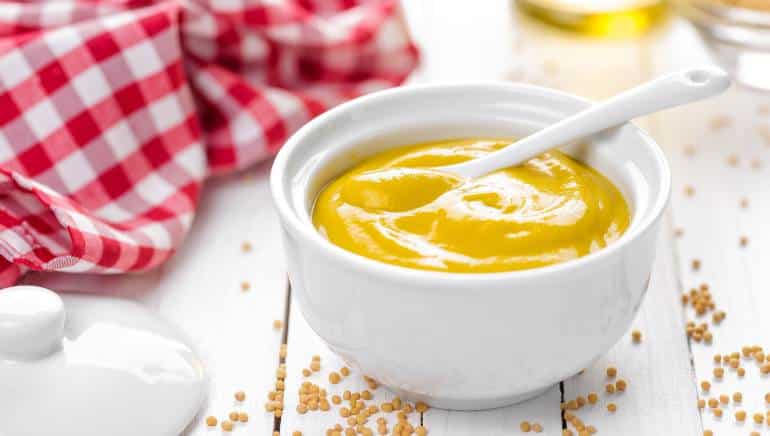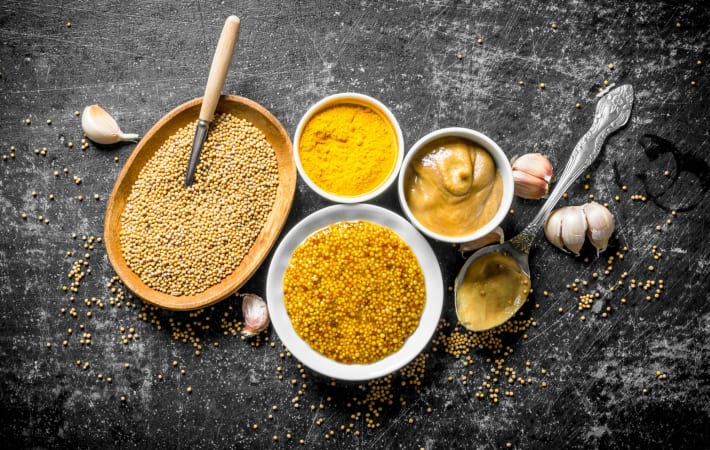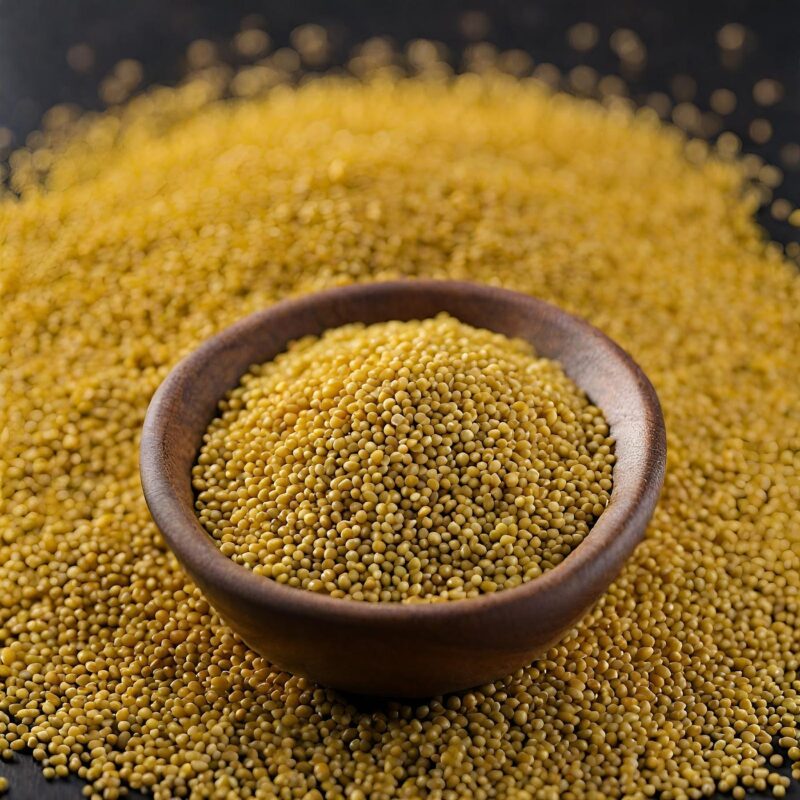What are mustard seeds used for in cooking?

Mustard seeds are versatile culinary gems that have been a staple in kitchens around the world for centuries. These tiny, round seeds, derived from the mustard plant, pack a powerful punch of flavor and are used in various forms to enhance the taste and aroma of a wide array of dishes. From imparting a subtle heat to providing a unique texture, mustard seeds contribute not only to the savory profile of dishes but also offer a myriad of health benefits.
One of the most common uses of mustard seeds in cooking is in the preparation of mustard condiments. The process involves grinding the seeds and combining them with liquid, such as vinegar or wine, to create the beloved condiment. The distinctive tangy flavor of mustard comes from enzymes in the seeds that are activated during the grinding process. Different varieties of mustard seeds, such as black, brown, and yellow, each contribute distinct nuances to the flavor profile of the condiment. Yellow mustard, made from the mild yellow mustard seeds, is the most common variety in the United States, known for its mild heat and bright color. Dijon mustard, a popular condiment in French cuisine, is made from brown or black mustard seeds and has a sharper, more robust flavor.
Mustard seeds are not only confined to the world of condiments; they are also widely used as a key ingredient in spice blends and seasoning mixes. In Indian cuisine, for example, mustard seeds are a fundamental component of the tempering process, where they are heated in oil until they pop and release their flavors. This tempering technique is known as “tadka” and is employed to infuse dishes with a rich, aromatic essence. Mustard seeds are integral to curry powders and spice blends, contributing both depth of flavor and a mild heat that complements the diverse range of spices found in these mixtures.
In addition to their flavor-enhancing properties, mustard seeds are prized for their unique texture when used whole in dishes. The seeds add a delightful crunch and pop to various recipes, making them a popular choice for pickling and preserving. Mustard seeds are often included in pickling brines, where their texture is preserved, and their pungency infuses the pickled vegetables or fruits with a zesty kick. Whether it’s pickled cucumbers, onions, or mangoes, mustard seeds play a crucial role in elevating the sensory experience of pickled delights.
Beyond their culinary applications, mustard seeds have earned a reputation for their health benefits. These tiny seeds are a rich source of nutrients, including calcium, magnesium, and phosphorus. They also contain compounds known as glucosinolates, which have been studied for their potential cancer-fighting properties. Additionally, mustard seeds are a good source of antioxidants, which help combat oxidative stress in the body. Some traditional medicinal practices even advocate the consumption of mustard seeds to aid digestion and alleviate respiratory issues.
Mustard seeds are not limited to savory dishes; they find their way into sweet preparations as well. In certain regional cuisines, particularly in parts of India, mustard seeds are incorporated into dessert recipes. The seeds are often ground into a fine powder and added to sweets, imparting a subtle warmth and complexity to the final product. This unconventional use of mustard seeds showcases their versatility and ability to transcend culinary boundaries.
In Mediterranean cuisine, mustard seeds are utilized in salad dressings to add a zesty kick and depth of flavor. The seeds are often combined with olive oil, vinegar, and various herbs and spices to create a vibrant and tangy dressing that enhances the freshness of salads. The addition of mustard seeds not only provides flavor but also contributes to the overall sensory experience, making salads more interesting and enjoyable.
Mustard seeds also play a significant role in meat and poultry dishes. Whether used as a rub, marinade, or seasoning, mustard seeds contribute a unique flavor profile that complements the richness of meats. The seeds are often ground and mixed with other spices to create flavorful rubs for grilled or roasted meats. The mild heat and pungency of mustard seeds help cut through the richness of fatty meats, adding balance and depth to the overall taste.
In Southern cuisine, especially in the United States, mustard seeds are a key ingredient in the preparation of chow-chow, a popular relish made with a variety of chopped vegetables. Mustard seeds not only contribute to the relish’s distinct flavor but also act as a natural preservative, allowing chow-chow to be stored for an extended period. The combination of mustard seeds with other ingredients like cabbage, bell peppers, and onions results in a relish that adds a burst of flavor to hot dogs, sandwiches, and other dishes.
Mustard seeds have also found a place in the world of baking. In some traditional European bread recipes, mustard seeds are incorporated to add a subtle spiciness and texture to the bread. The seeds can be sprinkled on top of the dough before baking or mixed directly into the dough itself. This unconventional use of mustard seeds showcases their adaptability and ability to enhance a wide range of culinary creations.
Furthermore, the oil extracted from mustard seeds is valued for its culinary and health benefits. Mustard oil is commonly used in Indian and Southeast Asian cuisines, prized for its distinctive pungency and high smoking point. It serves as a cooking medium for frying, sautéing, and even pickling. Mustard oil adds a robust flavor to dishes and is often used in the preparation of regional specialties such as Bengali fish curry and Assamese pickles.
The culinary journey of mustard seeds extends beyond their direct use in cooking, as they are also a crucial component in the production of mustard oil. Mustard oil, with its distinct pungency and rich flavor, is a popular cooking medium in various parts of the world. The process of extracting mustard oil involves cold-pressing the seeds, which helps retain the oil’s natural aroma and nutritional qualities. In addition to being a flavorful cooking oil, mustard oil is valued for its potential health benefits. It contains monounsaturated and polyunsaturated fats, which are considered heart-healthy, and it is rich in omega-3 fatty acids. The unique combination of nutrients in mustard oil makes it a sought-after ingredient for those looking to incorporate healthier cooking oils into their diets.
Mustard seeds are also employed in the preparation of marinades for meats and poultry. When ground into a paste with other spices, herbs, and liquids, mustard seeds create a flavorful and aromatic base for marinating various proteins. The seeds’ inherent pungency not only enhances the taste of the meat but also acts as a natural tenderizer. This dual function makes mustard seed marinades a popular choice for grilling, roasting, or slow-cooking meats, imparting a depth of flavor that goes beyond surface seasoning.
In the realm of vegetarian and vegan cuisine, mustard seeds play a pivotal role in elevating the flavors of plant-based dishes. They are frequently used in the tempering of lentils, beans, and vegetables, adding a burst of umami and complexity to these protein-rich dishes. Mustard seeds also find their way into vegetable stir-fries, where their unique texture and flavor contribute to the overall enjoyment of the dish. The seeds’ ability to enhance the taste of vegetarian fare highlights their versatility and makes them a valuable ingredient for those adhering to plant-based diets.
In pickling, mustard seeds go beyond their role as a textural element. The compounds within mustard seeds act as natural preservatives, aiding in the preservation of pickled items. The antimicrobial properties of mustard seeds make them an excellent choice for ensuring the longevity of pickled vegetables, fruits, and relishes. This dual functionality, both as a flavor enhancer and a preservative, has contributed to the widespread use of mustard seeds in pickling traditions around the globe.
The use of mustard seeds extends to regional and cultural specialties, where their presence is integral to the identity of certain dishes. For example, in Ethiopian cuisine, mustard seeds are a key ingredient in the spice blend known as “berbere,” which forms the foundation for many traditional Ethiopian stews, or “wats.” The combination of mustard seeds with other spices like fenugreek, coriander, and red pepper creates a complex and aromatic spice mixture that defines the bold flavors of Ethiopian cuisine.
Mustard seeds also find their way into the world of beverages. In some cultures, particularly in parts of Asia, mustard seeds are used to prepare a traditional drink known as “sarbat.” This refreshing beverage involves soaking mustard seeds in water, along with other ingredients like sugar and lemon juice, to create a cooling and tangy drink. While not as mainstream as some other beverages, mustard seed sarbat showcases the seeds’ adaptability in unexpected culinary domains.
The global popularity of mustard seeds is evident in their integration into fusion cuisine, where chefs blend culinary traditions to create innovative and unique dishes. Mustard seed-infused sauces, dressings, and marinades have become a hallmark of modern gastronomy, adding a touch of tradition to contemporary culinary creations. The seeds’ ability to bridge the gap between classic and avant-garde flavors highlights their enduring appeal in the ever-evolving landscape of global cuisine.
Beyond their applications in cooking, mustard seeds have historical and cultural significance. The use of mustard seeds in culinary practices can be traced back to ancient civilizations, where they were valued for their medicinal properties as well as their culinary contributions. The mustard plant itself has been mentioned in ancient Sanskrit writings and has a long history of cultivation in various parts of the world. This rich historical context adds a layer of depth to the role of mustard seeds in contemporary kitchens, connecting modern-day culinary practices with age-old traditions.
In conclusion, mustard seeds are indispensable in the culinary world, contributing to a diverse range of dishes across cultures and cuisines. From the familiar yellow mustard condiment to the exotic spice blends of Indian cuisine, and from the crunch of pickled vegetables to the unexpected addition to desserts, mustard seeds showcase their versatility and ability to elevate the culinary experience. Beyond their role in the kitchen, these tiny seeds also offer health benefits, making them a valuable addition to a well-rounded diet. Whether you’re a professional chef experimenting with complex flavors or a home cook seeking to enhance everyday meals, mustard seeds prove to be an essential and delightful ingredient in the world of cooking.
FAQ:
- What are mustard seeds, and where do they come from?
- Mustard seeds are small round seeds obtained from the mustard plant, scientifically known as Brassica juncea. These seeds come in different varieties, including black, brown, and yellow, and are used in various culinary applications.
- How do mustard seeds contribute to the flavor of dishes?
- Mustard seeds contribute a distinct flavor to dishes, ranging from mild to robust, depending on the variety. When ground or crushed, they release enzymes that create a tangy and slightly spicy taste, enhancing the overall flavor profile of the dish.
- What types of mustard condiments are commonly made with mustard seeds?
- Mustard condiments include yellow mustard, Dijon mustard, and whole grain mustard. Yellow mustard, made from yellow mustard seeds, is milder, while Dijon mustard, made from brown or black seeds, has a sharper flavor. Whole grain mustard retains the texture of the seeds, providing a unique culinary experience.
- Can mustard seeds be used in desserts?
- Yes, mustard seeds are occasionally used in desserts, especially in certain regional cuisines. They are ground into a powder and added to sweets, imparting a subtle warmth and complexity to the final product.
- What health benefits are associated with mustard seeds?
- Mustard seeds are rich in nutrients such as calcium, magnesium, and phosphorus. They also contain glucosinolates, which have potential cancer-fighting properties. Mustard seeds are a good source of antioxidants and have been traditionally used to aid digestion and respiratory issues.
- How are mustard seeds used in pickling?
- Mustard seeds are often included in pickling brines for their texture and flavor. They contribute a delightful crunch to pickled vegetables and fruits, and their natural antimicrobial properties help preserve the pickled items.
- What role do mustard seeds play in spice blends and seasonings?
- Mustard seeds are integral to spice blends and seasonings, especially in Indian cuisine. They are part of the tempering process, where they are heated in oil to release their flavors. Mustard seeds add depth and a mild heat to curry powders and various spice mixes.
- Can mustard seeds be used in vegetarian and vegan dishes?
- Absolutely! Mustard seeds enhance the flavors of vegetarian and vegan dishes, adding a burst of umami and complexity. They are commonly used in the tempering of lentils, beans, and vegetable stir-fries.
- How is mustard oil extracted, and what makes it unique?
- Mustard oil is extracted by cold-pressing mustard seeds. It is known for its distinctive pungency and rich flavor, making it a popular cooking oil, especially in Indian and Southeast Asian cuisines. Mustard oil contains heart-healthy fats and is rich in omega-3 fatty acids.
- Are there any cultural or regional specialties that prominently feature mustard seeds?
- Yes, mustard seeds are featured in various regional specialties. For example, in Ethiopian cuisine, they are part of the spice blend “berbere.” Mustard seeds are also used in Southern U.S. cuisine for making chow-chow, a flavorful relish. The cultural diversity in the use of mustard seeds highlights their global significance in culinary traditions.
Related Posts
What spices go with mustard seeds?
-
Posted by
akshita aishwarya
- 0 comments
What Indian dishes use mustard seeds?
-
Posted by
akshita aishwarya
- 0 comments




